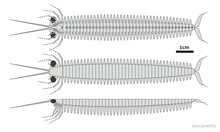Wingertshellicus
| Wingertshellicus Temporal range:
| |
|---|---|

| |
| Diagrammatic reconstruction of Wingertshellicus backesi | |
| Scientific classification | |
| Kingdom: | |
| Phylum: | |
| Subphylum: | |
| Genus: | Wingertshellicus Briggs & Bartles, 2001
|
| Species: | W. backesi Brigs & Bartles, 2001 (type)
|
| Binomial name | |
| Wingertshellicus backesi Brigs & Bartles, 2001
| |
| Synonyms | |
|
Devonohexapodus bocksbergensis Haas, Waloszek & Hartenberger, 2003[1] | |
Wingertshellicus is an
extinct genus of arthropod that has been found in Hunsrück Slate, that is located in the Rhenish Massif in Germany, and lived about 405 million years ago, during the Lower Emsian (part of the Lower Devonian).[2]
Etymology
Wingertshellicus has been named after the Wingertshell Member, part of the Hunsrück Slate near the German town of Bundenbach, in which it was found.[2]
Morphology
Wingertshellicus measured about 7.5 centimetres or 3.0 inches long.[3] The body of consists of just two main parts (tagmata): a short head and an elongated trunk.[1]
The head possess a pair of large
The trunk comprises about 40 similar segments (
somites), each carried a pair of biramous appendages with enlarged basipod (basal segment), flap-like exopods (outer branch) and slender endopods (inner branch).[3] The appendages were subequal, lacking any evidence of specializations.[1] the trunk terminated by a pair of fluke-like appendages with flagellate structures.[1]
Taxonomy
Wingertshellicus backesi was originally described in 2001 from specimens that were exposed on their belly (or
centipedes.[4]
However, detailed redescription in 2009 showed that the vertrally and laterally exposed specimen share the same
myriapods, crustaceans and hexapods) nor any known arthropod subgroups.[1]
References
- ^ .
- ^ .
- ^ .
- ^ Carapelli, A.; Nardi, F.; Dallai, R.; Boore, J.L.; Lio, P.; Frati, F. (2005). "Relationships between hexapods and crustaceans based on four mitochrondial genes". In Koenemann, S.; Jenner, R. (eds.). Crustacean Issues 16, Crustacea and Arthropod Relationships. CRC Press.
